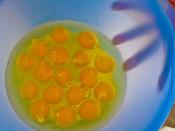Usman Omid Biology IB 1A
The Effect of Temperature on Beetroot Membranes
Aim
This practical will test the effect of temperature on the integrity of the membranes,
Introduction
The cells of beetroot contain a pigment called betalain in their vacuoles. It is kept inside the cells by the membranes. If these membranes are damaged, then the betalain leaks out. The amount that leaks out can be assessed, as the leaked out pigment will color the water surrounding the cells. This information can be used to find out how temperature affects cell membranes.
Hypothesis
Exposing the beetroot cells to a liquid environment (in this case water) with a temperature of 0 oC will keep the membranes intact because there is not energy transferred to the membrane and so it will not be bursting. The results are going to be more or less the same, until we exceed a temperature of 50 oC, because at this temperature most proteins will begin to denature.
�Then, if we increase the temperature above this, the cell membranes (which are made of proteins) will denature and soon burst and then the betalain will leak out and color the water red. As we keep increasing the temperature, the more betalain will leak out because the cell wall ought to burst faster with higher temperature and it is more certain that all cells will burst. When a cell wall bursts, it requires energy. This energy it takes from the nearby heat that is in the surrounding water. As it takes energy, the temperature of water in the surroundings will decrease. If we have the cells in a temperature of 50 oC, some cells will denature, but then the temperature of the surrounding water will decrease and the remaining cell membranes will not burst. Therefore it is more secure to...


